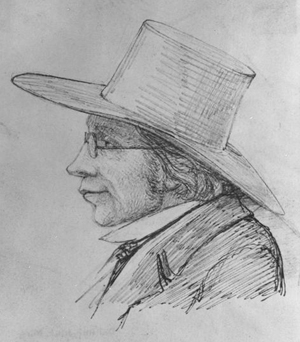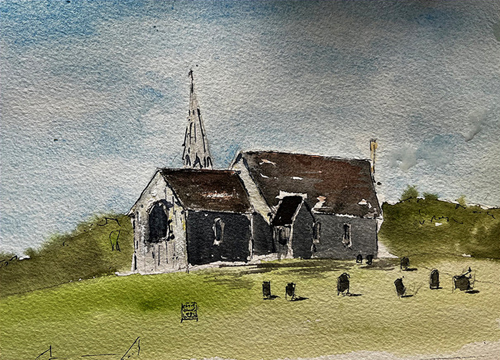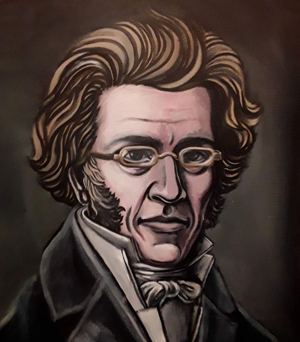
Your complimentary articles
You’ve read one of your four complimentary articles for this month.
You can read four articles free per month. To have complete access to the thousands of philosophy articles on this site, please
God and the Philosophers
A Theological Self
Stuart Hannabuss journeys into the human condition with Søren Kierkegaard.
We tend to think of faith as a matter of personal choice. It is very much up to you, we say, wishing to give other people the space to live their lives their way. We might think of ourselves all on a journey through life, growing physically, mentally, and perhaps spiritually.
It is often hard work since meaning and purpose are elusive and moral values contentious and slippery. It seems a lonely path; it is easy to lose hope and get depressed. ‘Keeping the faith’ is hard work at times: it calls for maturity and sensitivity to realise what a challenge it can be. We are often told, and may come to believe, that we fall short because we are not mature and sensitive enough, not far enough yet along the path of that life journey, and that’s why we feel unhappy. Not just marching to a different drum, but entirely on the wrong road.
We can give way to despair; and then that state of despair creates more despair – that self-reflexive spiral. Fernando Pessoa’s The Book of Disquiet (1991) speaks of being myself “at the centre that exists only because the geometry of the abyss demands it: I am the nothing around which all this spins, I exist so that I can spin.” This preoccupation with a loss of personal control is familiar today. It led Pessoa to refer to life as “a metaphysical mistake on the part of matter… We are isolated within ourselves from ourselves.”
A Leap of Faith
As we reflect on what it’s all for, it is natural to consider what others have said. Perhaps they might put our thoughts and feelings into words better than we can ourselves. Even when we disagree with them, it’s still worth doing. For some, the search for purpose and meaning takes them in the direction of religious faith, which can provide unique insights into issues of purpose, meaning, and values.

A contemporary sketch of Kierkegaard
Here it starts to get personal. Usually as we increasingly confirm what we believe and value there comes a tipping point where commitment and identity become involved. There’s a stage at which we feel obliged to commit to a basic position, and for some people this happens when rational inquiry and analysis based on empirical warrant seem inadequate to fully explain what to believe. The Danish philosopher Søren Kierkegaard (1813-55) – often thought of as ‘the father of existentialism’ – famously called this tipping point a ‘leap of faith’. Typically this involves an acknowledgement not just that you believe there is a God or supernatural dimension, or that you have a strong sense of the numinous (say in nature or in the cosmos), but a commitment to a firmly articulated ideology, creed, or dogma, such as ‘Jesus is the God-man’ or ‘the transformation of substance in the Eucharist’, to take Christian examples, since Kierkegaard was a Christian. This is going beyond what Socrates called ‘the unexamined life’ and moving into declaring ‘I believe’: and not just ‘I believe that …’ but ‘I believe in …’ – that is, to put your faith, a.k.a. trust in something, doing so in full acknowledgement that others might think us radically wrong. The leap of faith is a tricky step to take, because such faith is perceived as coming with baggage, such as guilt; so difficult that ‘fear and trembling’ (ironically, the title of one of Kierkegaard’s books) appears to capture what the leap of faith is all about. If we take the leap, others can always think we are mad, bad, or sad, as they choose.
Like so many long-dead authors, Kierkegaard may seem remote to us now. Many of the ideas and controversies of his time are of interest to specialists alone. Even so, there are parallels with his world and today’s. Secular or not, we still try to understand the implications of what we actually believe in and why: those grand existential questions, which for the believer include the paradox of material corruption and the divine, or the truth claims of a dwindling church, or making sense of concepts like redemption. We wonder at times whether our decision to believe has been made too subjectively or emotionally, without enough rational investigation and reflection. Then we ask whether being too rational can get in the way. We both respect and doubt ourselves for harbouring doubts about our beliefs. We call our faith by the more neutral and socially-acceptable word ‘belief’, because we all have beliefs, many of them completely innocuous. But since faith entails pendulum swings from joy to doubt, for many the journey is arduous. John Bunyan’s The Pilgrim’s Progress (1678), in which Christian faces off the giants Despair and Apollyon and the dangers of Vanity Fair, is now for many a mere literary curiosity. The New Atheists like Richard Dawkins aren’t the only ones to have deconstructed traditional religious ideas and the assumptions on which they’re based. Nowadays Kierkegaard’s scepticism about the church is widely shared. In his day he was well-known as anti-clerical: today the issue seems obsolete except where faith claims and real life clash, as on gay marriage, for example. Yet, all that having been said, we nevertheless subscribe to the idea – the optimistic narrative – that life is indeed a journey and we are making progress on it, even if we’re moving like crabs.

‘Kierkegaard’ is Danish for ‘Churchyard’. Painting by Chris Gill 2022
The Sickness Unto Death: Insight into the Self
These are all themes explored by Kierkegaard. In the title of his book The Sickness unto Death (1849) he refers to a phrase of Jesus’s in John 11:4, “This sickness is not unto death”, where Jesus is explaining to the disciples that the dead Lazarus has only ‘fallen asleep’ and can be awakened. Kierkegaard uses the phrase as a launch-pad for a subtle investigation into psychological and spiritual growth, or; how and why it is that we believe. Kierkegaard’s overall argument in The Sickness unto Death is that personal growth at best aspires to attain a spiritual relationship with God – and not just acknowledging ‘God up there’, but the possibility of a human encounter with the divine through Jesus Christ.
Kierkegaard’s writings – originally in Danish but long since available in English – are no easy read. His style is intricate, he uses several noms de plume to represent variant points of view, and the content is complex anyway. Nevertheless, The Sickness unto Death speaks to us today, and not merely to people of faith. In part this is because what he says in it about the self and self-awareness is still relevant and convincing. There are times when we don’t want to be ourselves, when our very self-consciousness seems to make things worse – when we’re ‘isolated within ourselves from ourselves’. We get busy with the ‘immediate’, and this reduces and impedes our sense of what is possible: ‘possibility is a mirror that does not tell the truth’. So we feel frustration and despair. One paradox of self-awareness is that it encourages us to rationalise our feelings of despair yet makes us feel vulnerable to them. Kierkegaard says that fatalism and stoicism – ideas which have often been seen as a seed-bed for existentialism – are of little help. All we have left is to think for ourselves about meaning and purpose. These are presented as illusions in the existential novels of Albert Camus (above all, in The Plague, 1947), but Kierkegaard takes our search for spiritual identity in very much a Christian direction.
A Socratic Way: An Inability to Understand
The Sickness unto Death has an interesting subtitle: A Christian Psychological Exposition for Upbuilding and Awakening. Many books have been published on themes like this, as a branch of the well-being and mindfulness wave. They highlight personal growth and self-knowledge – things many of us look for in one place after another, often in vain. Examples extend from textbooks like Kate Loewenthal’s Mental Health and Religion (1995) to pastoral guides like Samuel Wells’s Love Mercy: the Twelve Steps of Forgiveness (2020). Some take us confidently towards a deeper, fuller faith, while others comment on how interesting, and perhaps misleading, the journey is.
The ‘Socratic method’ refers to the technique used by Socrates (as reported in Plato’s dialogues) to elicit the truth about what people really think, as opposed to what they thought they think. Socrates coaxes his interlocutors to the position where they realise that they didn’t know what they thought they knew after all. Socrates called it a kind of ‘midwifery’. Kierkegaard uses the framework of the Socratic method in two interesting ways. First he draws us through a series of stages discussing our personal growth from self-awareness through depression to deeper faith. Secondly he encourages us to acknowledge that only by accepting faith as a destination, and grace as a means, can we fully grow.
In order to get there (we see this in his writings as a whole) Kierkegaard knew he had to examine the core problem of faith, which he, like the New Atheists today, understood as ‘belief in what cannot be proven’. For him, Christian belief involved a paradox, a dialectic of two opposites: belief and uncertainty. In the arena of theology there are many such tensions – between rational analysis and personal spiritual experience; objectivity and subjectivity; free will and God’s omniscience; or appearance and reality. Kierkegaard thought he had to engage with all this in order to find his way on faith – something we must also do today if we want to make this choice. Today in our ‘spiritual journey’ (call it what you will), we know opposition-pairs such as religion and secularism, or personal freedom and social obligation. And the many ‘honest to God’ [with regard to doubts] re-interpretations of religion in recent years – for instance, deconstructing the anthropomorphic idea of God, or debunking the virgin birth or images of heaven – indicate how things keep changing. Ultimately, Kierkegaard suggested, Socrates was concerned with knowledge, yet spiritual awakening goes beyond that. The evidential base, and the matter and manner of the journey, are different.
A Christian Way & its Claims

Kierkegaard from a different angle by Woodrow Cowher
In The Sickness unto Death Kierkegaard tries to tease out what form a spiritual journey might take. Being self-aware is necessary for personal growth, yet makes us vulnerable to despair. And even if we do not think of it in terms of sin, guilt is bad enough to cast us down, triggering despair upon experiencing it. We feel despair at being alone – the idea of existential angst we often hear about stems originally from Kierkegaard – and we often distrust the promptings of conscience, which seem unreliably subjective and vulnerable merely to what we think we want and how we feel. But to think in terms of society’s expectations distracts us from the personal, which is the locus of change. So for Kierkegaard then (as for many of us now), the church does not help, being ritualistic, pedantic, and condescending. His view of contemporary preaching was that it was mediocre. Just as today, it was often trite, theologically naïve, and sententiously delivered. But this is where his ideas about subjectivity matter, because for him subjective experience of God or religious truth is a core component of, even a pre-requisite, for faith, even if at times it seems to be an oxymoron – rely on your own impressions of the real, while admitting they may well be wrong.
In the final section of The Sickness unto Death Kierkegaard examines “the despair that is conscious of being despair and therefore is conscious of having a self in which there is something eternal.” Thinking both about the personal dilemmas of the believer and the wider indifference to spirituality in his society, Kierkegaard returns to the ways in which the immediacy of the busy world impedes our view of what is possible, even making the possible into an ‘illusion’. Kierkegaard sees despair in two ways. The despair that best copes with despair is ‘a feminine despair’, he says: ‘despair not to will to be oneself: despair in weakness’. The typical ‘masculine’ approach is to rely far more on ‘defying’ the thing despaired of. But perhaps we can understand this best not in crude gender terms, but with reference to the central paradox of the Christian faith – of God becoming man in Jesus Christ – in which His very weakness became His strength.
The Isolated Self is Male & Female

Lone Journey by Dror Rosenski 2022
Kierkegaard then shifts ground to consider whether there is a typology of belief and response. Again he uses the categories ‘masculine’ and ‘feminine’, but instead of talking in terms of biology, he characterises the ‘feminine’ (for example) as an attitude, which he explicitly says is not literally feminine in the sense that ‘women’ (let alone all women) are like this. Rather, the attitude like that of Jesus himself as he appears in the Gospels, washing the feet of the disciples, or as the wounded healer offering grace through pain and sacrifice. Something, then, at the heart of the Christian paradox that ‘blessed are the meek’, ‘turn the other cheek’, ‘love your neighbour…’ However, for any modern reader this raises semantic and sociological questions, as to, for example, whether there is something inherently ‘feminine’ and ‘submissive’ about being susceptible to an awareness of the numinous; whether women really are more ‘religious’ than men; even whether women are more spiritually gullible than men. Kierkegaard does not pursue the analogy this far: his feminine is merely a device for defining one kind of faith response which he claims starkly contrasts with the other.
Clearly, the other approach is ‘masculine’. In a surprisingly modern way Kierkegaard argues that many us – and arguably, especially men – deal with despair with stoic defiance. They take a pull-your-socks-up attitude: God helps those who help themselves; deal with it; man up. Kierkegaard characterises this stance as ‘I refuse to be erased’ – a statement which has all the heroic tone of the existentialist. However, his wider argument is that this defiant stoicism impedes both psychological and spiritual growth, because it emphasises passivity in the face of suffering and leads to denial or repression of feelings – a closing-in of personality and spirit. This has personal resonance for Kierkegaard, not only because it is set within a case for understanding the spiritual journey best through accepting the central role of subjective experience, but also because Kierkegaard is, like Schopenhauer, a gloomy commentator on human affairs. For that reason alone he might be misunderstood today.
Conclusions
Kierkegaard’s description of spiritual growth is psychologically relevant today for its emphasis on subjectivity and coping with depression. It is also theologically relevant for its thoughts on how far (or whether) personal growth is, and should be seen as, a spiritual journey. Both aspects are evidently relevant to professional work in therapy, or pastoral care and spiritual direction, and his emphasis on the subjective and the reflective self chimes with modern psychotherapy and mental health practice.
Kierkegaard speaks of ‘the theological self’. His examination of the journey of the self might lead in directions which many of us, as atheists, agnostics or humanists, find illogical and implausible; but his call for us to make both an external and an internal journey of discovery and self-discovery is nonetheless entirely valid. His work may seem long ago and far away, yet revisiting it can offer us unexpected insights.
© Dr Stuart Hannabuss 2022
Stuart Hannabuss is a retired honorary chaplain at the University of Aberdeen and voluntary counsellor for NHS Scotland.








